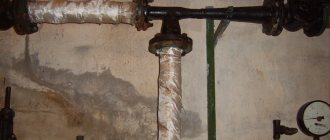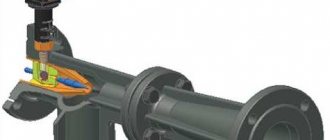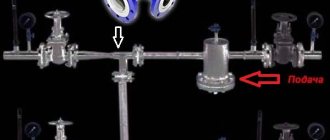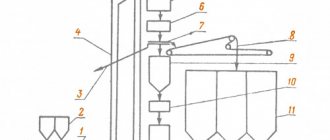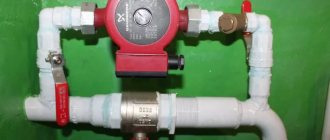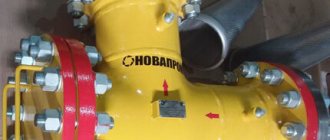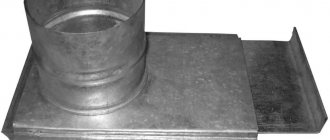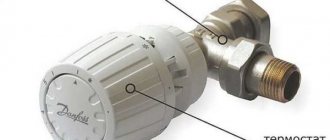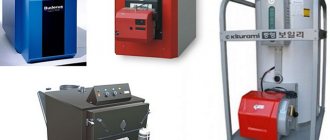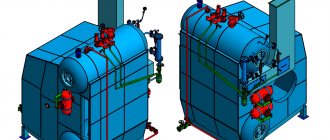The elevator unit is specialized equipment located in the thermal distribution center. The main tasks of this device are: increasing the volume of heated water, reducing its pressure and t, as well as pumping. The operation of conventional elevators is adjusted by reducing or increasing the size of the component parts. There are also mechanically and electrically adjustable elevators.
The functioning of the heating system schematically Source elevator66.ru
The essence of the elevator unit
The elevator unit of the heating system is a special functional mechanism that is part of the heating equipment of the house. In essence, it acts as a water jet or ejection pump.
Thanks to its design, the elevator allows you to increase the pressure in the heating system, while increasing the volume of the coolant (an increase in the amount of water is obtained due to its high temperature and the same high pressure). This means that the water in the pipes heats up to 150°C without turning into steam due to the closed space. In addition, increased pressure is generated in the elevator. All of the above conditions created by the elevator device contribute to a subsequent more efficient supply of heat to the heating pipes.
Heating elevator Source blmz.rf
After the 150-degree water has reached the place of its direct use, the elevator is turned on. It must lower the temperature and pressure of the water, because in such a heated state, the coolant cannot enter the heating systems. Otherwise, cast iron batteries and pipes will deteriorate and there will even be a possibility of their rupture, which can have dire consequences. Even if the radiators are not cast iron, but are made of another metal, there is a chance of getting burned.
This is interesting! The water is not necessarily heated to 150°C; there are also other operating modes - with an input temperature of 130°C, 95°C (as an option 90°C).
Let's sum it up
In most basements of large residential and industrial buildings, the classic elevator heating unit, invented many years ago, is still installed. However, technology does not stand still.
Today, the market offers modern devices that regulate temperature automatically. They are considered more energy-efficient and economical, but their operation is impossible without a connection to the electrical network.
A thermal power plant, burning natural gas, fuel oil or coal, heats water to a temperature of 115°C under high pressure. High-temperature water vapor hits the turbine blades, which rotates a three-phase alternator. Electricity is supplied to supply residential buildings and industrial enterprises, and waste steam heats apartments and enterprises.
Principles of operation of the elevator unit
You already know a little about the elevator unit of the heating system and what it is. Let's take a closer look at how this device functions. It contains 3 flanges into which the inlet and outlet (return) pipes are inserted, as well as a pipeline through which water goes directly to the heat consumer.
The principle of operation of the elevator is as follows: c: first, heated water from the common line enters the pipe of the device in question.
The principle of operation of the elevator Source 1-teplodom.ru
Since the coolant is under pressure, it moves a little further, passing through a narrow nozzle. In this case, an injection effect or Venturi effect occurs, that is, a vacuum zone is created in the next chamber (receiving chamber). Since this chamber has a reduced pressure, the law of thermodynamics begins to operate and cold water from another pipe begins to be sucked into this part of the elevator assembly. The second pipe is connected to the so-called return pipe.
This is interesting! Venturi's law states that the pressure of a fluid drops as it passes through a narrow part of a pipe. At the same time, Bernoulli's law explains why this happens.
As a result of the above processes, in the next part of the device, which is called the mixing neck, hot and cold water are mixed and the pressure is reduced. After this normal temperature, the liquid is sent directly to the system that heats the house in the winter.
Visually about Venturi's law Source stack.imgur.com
Thus, in addition to reducing the operating parameters of the system, the elevator also performs the function of a pump. One of the most important tasks that an elevator solves is creating the necessary and suitable pressure that can overcome the water resistance of the heating system of the house. To do this, a vertical jumper at the joint is cut at an angle of 450. This contributes to better separation of water flows.
The elevator structure contains other elements that are important and important for heat supply. This device is also equipped with filters and piping, which includes:
- pressure gauges (to monitor system pressure);
- filters (free from dirt);
- thermometers (for temperature control; located in three places of the system);
- valves (needed for access to the inside of the system, as well as for emergency and other work).
Filters used in the elevator can be of two types: dirt-collecting or mesh-magnetic. The former remove the largest debris from the coolant, the latter are responsible for purifying the water that enters home heating radiators and pipes.
Pressure gauges, valves and other elevator fittings Source tildacdn.com
Let's consider why an elevator is needed. This device is used mainly in centralized heating systems, namely where the temperature rises to one hundred and fifty degrees Celsius, the pressure is 6-10 bar. This is necessary in order to:
- equipment operating at high temperatures functioned properly and with a high efficiency;
- deliver sufficiently heated water to areas remote from the boiler room;
- save resources (due to the fact that water heated to a temperature of more than 100°C and having increased pressure contains more thermal energy than colder water, for example, ninety degrees).
See also: Catalog of companies that specialize in engineering systems (heating, water supply, sewerage and others) and related work
Some features of the heating elevator
When considering the question of what an elevator unit is, it is worthwhile to dwell separately on the features of its arrangement for heating a house.
Heating elements Source tvoidom-msk.ru
When designing a heating system, special attention should be paid to the ratio of the resistance of the device to the pressure created inside the pipe that supplies water. It is optimal if this ratio is 1 to 7. The pressure difference between the supply and return circuits is also important. It is necessary to strive to ensure that these indicators coincide, then the system is considered fully operational. Deviation is allowed, but not more than 0.5 kgf/cm3.
Adjustable devices
The practice of using heating elevators shows that the use of adjustable devices is more necessary for foreign realities: Russian cold winters usually require good, stable heating of residential premises and there is no need to constantly change the temperature of the coolant.
Also, adjustable elevators are used for heating non-residential premises: if you lower the temperature at night, when there are no clients or visitors, you can achieve savings of up to 30%. Regulation of the coolant using such a heating elevator is carried out using a special additional relay equipped with an electric drive.
Auto elevator Source rusinfo.info
Comb
When a heated object, that is, a house with several floors, needs to install a special distributor that supplies heat to each individual object or to each room. To do this, use special additional equipment - a comb (also known as a collector).
The essence of the operation of this equipment is as follows: the coolant, ready for heating, flows out of the elevator outlet and enters the collector. After this, the comb distributes water to consumers with the same pressure. In this case, the operation of the entire system does not stop, and the mutual influence of its branches is excluded. In addition, the pressure in the batteries corresponds to the pressure at the elevator outlet.
Additional elements of the heating system
Increased interest in the question of what an elevator is in a heating system has recently arisen for a reason. The point is the constantly rising prices for housing and communal services. In such conditions, owners of private houses are thinking about obtaining savings and normal air temperatures in the winter.
Heating elevator Source maklakova25.1c-umi.ru
This can be done by using additional elements that reduce unnecessary energy consumption:
- circulation pumps;
- protective elements for pipes;
- water purification systems;
- various automatic devices aimed at controlling the comfortable heating mode of the coolant.
Example of implementation of scheme 1 ACU
Schematic diagram of an automated control unit with a sufficient available pressure drop at the inlet
(P1 - P2 > 6 m water column) for temperatures up to AUU t = 95-70 °C
The modern world has long been unable to cope without innovative technologies. There is not a single technology or system that does not use revolutionary solutions. The heating system was no exception. This is due to the fact that this is a fairly significant technology, which is designed to ensure a comfortable existence.
For obvious reasons, special attention is paid when designing a house. Since ancient times, houses were built from the stove, that is, first the stove was built, and then it was covered with walls and a ceiling. This was done for a reason, for this we need to say “thank you” to our climate
This was done for a reason; for this we need to say “thank you” to our climate.
Starting from the middle zone of our spacious country and ending with distant Sakhalin, rather uncomfortable temperatures reign for most of the year. The thermometer ranges from +30 to -50 degrees.
Due to the rather complex temperature resonance, the heating system is as important as the electrical supply. Previously, a competent stove maker who knew how to make a proper stove was valued at the level of a blacksmith. After all, you need to correctly calculate the size of the firebox, the diameter of the chimney, and besides, the stove had to be multifunctional:
- food was prepared in it;
- it heated the room;
- warmed up the water;
- served as a small sleeping place.
That is why the construction of the furnace was complex and time-consuming. It had to have sufficient draft to ensure that all combustion products did not enter the room. But with all this, she had to be economical.
Today, fundamentally little has changed. The main functions and requirements for the heating system remain the same:
- saving;
- maximum efficiency;
- multifunctionality;
- simplicity of design;
- quality and durability;
- minimal operating costs;
- safety.
Fire was the first source of heat for humans. And even now its relevance has not lost its significance. The most primitive way of heating was to make a fire, which provided protection from predators, low temperatures, and served as a source of light.
Further, over time, humanity began to tame the gift of Hermes. Ovens appeared, they were usually built from clay and stones. Later, with the advancement of technology, ceramic bricks began to be used. And it was then that the first ones appeared.
Steel furnaces appeared much later; they determined the formation of the Steel Age. The fuel for the stoves was coal, wood, and peat. With the gasification of cities, furnaces became available. And all this time, man sought to improve the heating system.
"Pros" and "cons" of the elevator
An elevator unit is, at first glance, a very convenient and functional device, but it has its drawbacks.
Basic facts about the elevator Source akak7.ru
The negative sides of the elevator include the inability to control the temperature at the outlet of the system and the difficulty in calculating the required length, cone size and mixing chamber. The first problem is sometimes solved with the help of an electric drive, which can move a special metal needle in the shape of a cone. This is how the diameter changes, this is important for coolant temperatures. It is also possible to install a manual drive. Another negative aspect of using an elevator heating system is the need to provide a large drop in water pressure.
Among other difficulties, it is worth highlighting the following nuances:
- the need for individual selection of a unit for each specific task;
- lack of smooth adjustment of temperature conditions, since to change the parameters of a conventional elevator unit it will be necessary to change one nozzle to another;
- the need to create conditions such that the difference between the supply and return circuits is from 0 to a maximum of 0.5 bar;
- complexity of installation;
- The elevator cannot be used for a local heating circuit.
Polypropylene
PPTs are made of polypropylene sheets sandwiched between a thin sheet of aluminum foil. When producing pipes, polypropylene sheets are smeared with adhesive mastic, thin aluminum foil is placed between them, rolled into a roll, placed on a hollow rod, the edges at the joint are cut at an angle of 45 degrees, lubricated with acrylic gel and heated with a special hairdryer. These pipes are not subject to corrosion; rust and bacterial plaque do not settle on their inner walls. The pipes are connected to each other at right angles using plastic or threaded metal fittings.
Methods for connecting plastic pipes:
- gluing or cold welding;
- connection using a threaded coupling;
- plasma high temperature welding;
- overhead metal flanges;
- welding using an electric coupling.
Video description
The following video will tell you how the elevator unit works:
If we talk about single-pipe house systems with an elevator, when starting them, it is necessary to perform a number of mandatory actions. First of all, you need to bleed the air from the return riser, and only at the second stage will you need to release the accumulated air from the supply riser, while opening the main valve.
The “advantages” of using an elevator unit include:
- independence of the device from other devices and electricity (this applies only to non-automatic elevators);
- simplicity of the elevator scheme (design);
- ease of system maintenance;
- independence from the external environment (the mixing coefficient of coolants of different temperatures does not depend on the external temperature);
- durability (thanks to its simple design, the elevator can serve for a long time without repairs or replacement of parts);
- functionality (the elevator unit has two more useful functions - it also acts as a pump and mixer);
- low cost (the metal parts that make up the elevator are inexpensive and not rare).
Node calculation
Elevator units of the heating system are the central elements of heating systems that heat residential or non-residential premises without unnecessary heat consumption. Since these systems may differ in the number of objects served, it is necessary to calculate the elevator so that the installed device works correctly. The essence of such calculation of the parameters of the future elevator is that it is necessary to find out two numbers: the size of the chamber for mixing liquids (d) and the nozzle (dс).
The size (diameter) of the internal chamber mixing water of different temperatures is calculated by the formula:
d = 0.874 * √Gpr,
where Gpr is the amount of mixed water (given), indicated in tons per hour.
To calculate the amount of water, you need to substitute the values into the following formula:
Gpr = Gс / √h = Q / [(tcm – tob) * √h * 1000],
where Gс is the estimated water consumption (t/h);
h – reverse effect from the heating system (resistance; measured in meters of water column);
Q – amount of heat consumed (in kilocalories per hour);
tcm, tob - denotes t of the water mixture that goes for heating, and, accordingly, the cooled water that goes back, that is, through the return (expressed in degrees Celsius).
Video description
In this video you will see how to disassemble and install a nozzle in an elevator:
Now you need to determine the size (diameter) of the nozzle (dc) using the formula below:
dс = 10d / √[0.78 / Gpr2 * (1 + u)2 * d4 + 0.6(1 + u)2 – 0.4u2],
where u is the dimensionless injection or mixing coefficient.
Next, to calculate u, you need to calculate u` using the formula:
u` = (t1 – tcm) / (tcm – tob),
where t1 is the temperature of the coolant at the entrance to the elevator (in °C).
To calculate u, you need to substitute the value of the coefficient u` into the formula:
u = u` * 1.15.
After the calculation, all that remains is to select the desired nozzle. They are available in several sizes and are marked with numbers from 0 to 7. You need to choose the one that is closer in size to the calculated value (see table No. 1).
Table No. 1. Nozzle diameter.
| Nozzle size | Water consumption, t/hour | Nozzle weight, kg | Nozzle neck diameter, cm |
| 0 | 0,1-0,4 | 6,4 | 1 |
| 1 | 0,5-1 | 8,1 | 1,5 |
| 2 | 1-2 | 8,1 | 2 |
| 3 | 1-3 | 12,5 | 2,5 |
| 4 | 3-5 | 12,5 | 3 |
| 5 | 5-10 | 13 | 3,5 |
| 6 | 10-15 | 18 | 4,7 |
| 7 | 15-25 | 18,5 | 5,9 |
Video description
The following video describes in detail about heating points:
The nozzle is also changed when it turns out that it is necessary to increase/lower the temperature of the water supplied to the heating system of the house.
Sometimes, to change the parameters of the coolant without replacing parts, valves (manual dampers) are installed in the elevator in the heating system, but this does not really help the problem. The fact is that with such a manual, even artisanal method of adjustment, it will not be possible to achieve uniform distribution of water throughout the entire heating system.
About repairs
If the inlet and outlet temperatures of the coolant do not correspond to the standard, this indicates a breakdown or improper operation of the heating elevator.
Elevator on the diagram Source i3.guns.ru
At equal temperatures, there is a possibility of the elevator becoming clogged or the nozzle diameter needs to be reduced. If a very large difference is detected between the indicated indicators, the device should be stopped and repaired. You also need to pay attention to the elevator if part of the heated premises does not receive enough heat. All parts of the elevator are checked for serviceability before the start of each heating season.
Three way valve
If it is necessary to divide the coolant flow between two consumers, a three-way heating valve is used, which can operate in two modes:
- constant mode;
- variable hydraulic mode.
A three-way valve is installed in those places in the heating circuit where it may be necessary to divide or completely shut off the flow of water. The tap material is steel, cast iron or brass. Inside the faucet there is a shut-off device, which can be ball, cylindrical or conical. The tap resembles a tee and, depending on the connection, a three-way valve on a heating system can work as a mixer. Mixing proportions can be varied within wide limits.
The ball valve is mainly used for:
- adjusting the temperature of heated floors;
- adjusting battery temperature;
- distribution of coolant in two directions.
There are two types of three-way valves - shut-off and control valves. In principle, they are almost equivalent, but with three-way shut-off valves it is more difficult to regulate the temperature smoothly.
- How to fill water into an open and closed heating system?
- Popular floor-standing gas boiler made in Russia
- How to properly bleed air from a heating radiator?
- Expansion tank for closed heating: device and principle of operation
- Gas double-circuit wall-mounted boiler Navien: error codes for malfunctions
Recommended reading
Expansion membrane tank of a heating system: device and functions Heating thermostat - operating principle of different types Bypass in a heating system - what is it and why is it needed? How to accurately choose an expansion tank for heating?
2016–2017 — Leading heating portal. All rights reserved and protected by law
Copying site materials is prohibited. Any copyright infringement will result in legal liability. Contacts
